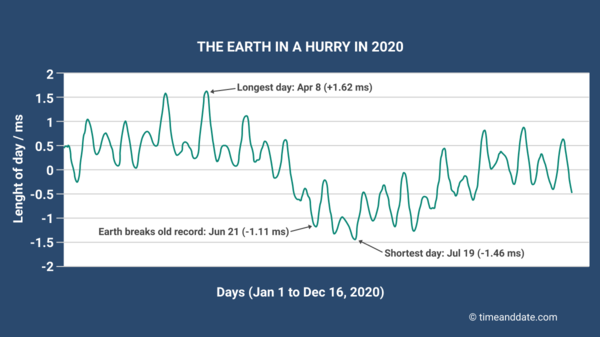“LEAP SECOND TIME ADJUSTMENT DAY”

Image via NASA.
Why do we need a leap second?
Isn’t the length of our day set by the rotation of the Earth? Like the ancients who insisted that all motion in the heavens must be perfect, uniform and unvarying, many of us today assume that the Earth’s rotation – its spin on its axis – is perfectly steady. We learned, correctly, that the sun, moon, stars and planets parade across our sky because the Earth turns. So it is easy to understand why we assume that the Earth’s rotation is precise and unwavering. Yet Earth’s rotation does not stay perfectly steady.
Instead, compared to modern timekeeping methods such as atomic clocks, the Earth is a notoriously poor timepiece. Overall, as many know, Earth’s spin is slowing down. The length of our day is increasing. The Wikipedia entry on this subject explains it well:
Earth’s rotation is slowing slightly with time; thus, a day was shorter in the past. This is due to the tidal effects the moon has on Earth’s rotation. Atomic clocks show that a modern day is longer by about 1.7 milliseconds than a century ago, slowly increasing the rate at which UTC is adjusted by leap seconds. Analysis of historical astronomical records shows a slowing trend; the length of a day increased about 2.3 milliseconds per century since the 8th century BCE.
Earth’s rotation is slowing, but it can also speed up
The slowing is an overall trend. The speedup is more of a day-to-day phenomenon. The website timeanddate.com has a very interesting article on a slight speedup in Earth’s rotation in 2020.
The fact is Earth’s rotation is subject to effects that are hard to predict. Other short-term and unpredictable changes result from a variety of events. These range from slight changes in the distribution of mass in the Earth’s molten outer core, to movement of large masses of ice near the poles, to density and angular momentum variations in the Earth’s atmosphere.
For example, you might recall the devastating Fukushima earthquake that struck in northeastern Japan in 2011. The quake was magnitude 9.0, the largest ever recorded in Japan. It was the world’s fourth-biggest earthquake since 1900. It unleashed a powerful tsunami that caused the death of some 16,000 people and caused a nuclear meltdown at Fukushima Daiichi Nuclear Power Plant. The quake also caused displacements of portions of the Earth’s crust that sped up Earth’s rotation, shortening the day by 1.6 millionth of a second.

The tides affect Earth’s rotation
If you have ever been to the beach, you will be familiar with the main reason our planet is slowing down. That reason is ocean tides. As our planet rotates, it plows past the great watery bulges (raised mostly by the gravitational interaction of the Earth and moon), which serves to slow it down much like a brake on a rotating wheel. This effect is small, actually very small. According to calculations based on the timing of ancient astronomical events (eclipses), the Earth’s rotation has slowed down by about 0.0015 to 0.002 seconds per day per century.
In other words, the days are becoming longer by about 0.002 seconds per day. But the rate at which this increase occurs also grows slowly over time. Currently that rate is also about 0.002 seconds, but per 100 years.
So the Earth is slowing down, very slowly. What happens, though, is that the daily 0.002-second difference between the original definition of a day (86,400 seconds) builds up.
After one day it is 0.002 seconds. After two days it is 0.004 seconds. By three days it is 0.006 seconds and so on. In about a year and a half, the difference mounts to about 1 second. It is this difference that has prompted the addition of a leap second.
Atomic clocks (which are accurate to about a billionth of a second per day) track all of this to an extremely high precision.
The inconstant Earth
Of course, the slowdown is not constant either. According to the U.S. Naval Observatory, from 1973 to 2008 the variation in Earth’s spin has ranged from plus 4 milliseconds to minus 1 millisecond. Over time, that could necessitate a negative leap second, signifying an increase in the Earth’s rotation speed.
But, since the concept of leap seconds began in 1973, this has never happened.
And, by the way, if this fine detail on timekeeping seems esoteric or unimportant to you, realize that it’s not to the telecommunications industry.

Not everyone thinks a leap second is a good idea
The International Telecommunications Union (ITU), a United Nations body that governs some global issues related to time, has been contemplating leap seconds for some time. They considered abolishing the practice, but in November 2015 – with delegates from more than 150 nations meeting in Geneva – the ITU announced it had decided not to dump the leap second, at least not right now. The ITU said:
Leap Second Time Adjustment Day is listed as an observance title only. Some years scientists do not make adjustments. But, if they do, then it’s done on either June 30 or December 31.
The majority of the world measures time solely based on a 24 hour day in which each hour contains 60 minutes, and each minute contains 60 seconds. That measurement is much too simple for accurate time measurement.
since about 140 AD, scientists have attempted to break down the hours in the day into a consistent and precise means of measure. Due to the variability of the Earth’s rotation, measurement of the 24 hour day is not an exact science. There is some dispute over the validity of leap second adjustments. Some years scientists do not make adjustments. But, if they do, then it’s done on either June 30 or December 31.
HOW TO OBSERVE #LeapSecondTimeAdjustmentDay
Whether an adjustment is made or not, here are ways to celebrate:
- Watch an episode of Quantum Leap.
- Play the game leapfrog.
- Listen to “Leap of Faith” by Bruce Springsteen.
- Sneak up on someone and see if you can scare them into leaping into the air.
- Leap for joy.
- Watch the moon landing and listen for Neil Armstrong’s famous quote.
- Sing the 12 Days of Christmas and see if you remember which day leaps.
- Take a leap of faith.
Use #LeapSecondTimeAdjustmentDay to post on social media.
LEAP SECOND TIME ADJUSTMENT DAY HISTORY
Scientists first introduced the leap-second system in 1972.
Posted in Family, Grandma, Today and tagged "Mickey McLaren" -" herself"with no comments yet.
Leave a Reply